ASP.NET-MVC-Part-1.ppt
- 1. ASP.NET MVC Part I Ventsislav Popov Developer Evangelist at Microsoft ventsypopov.com ventsypopov.com
- 2. Agenda ïŪ Beforehand â ASP.NET Web Forms ïŪ What is MVC ïŪ What is ASP.NET MVC? ïŪ Models ïŪ Views ïŪ Controllers ïŪ Validation ïŪ Routing ïŪ UnitTests ïŪ View engines 2 ventsypopov.com
- 3. ASP.NET Web Forms ïŪ Rich controls and tools ïŪ Postbacks ïŪ Event driven web development ïŪ Viewstate ïŪ Less control over the HTML ïŪ Hard to test ïŪ Rapid development 3 ventsypopov.com
- 4. Letâs chat for a bitâĶ 4 ventsypopov.com
- 6. Model âView - Controller 6 ïŪ Controller - responsible for handling all user input ïŪ Model - represents the logic of the application ïŪ View - the visual representation of the model ventsypopov.com
- 7. ASP.NET MVC ïŪ More control over HTML ïŪ No Codebehind ïŪ Separation of concerns ïŪ Easy to test ïŪ URL routing ïŪ No postbacks ïŪ NoViewState 7 ventsypopov.com
- 8. Models ïŪ The model should contain all of the application business logic, validation logic, and database access logic. ïŪ ASP.NET MVC is compatible with any data access technology (for example LINQ to SQL) ïŪ All .edmx files, .dbml files etc. are located in the Models folder. 8 ventsypopov.com
- 9. Custom View Models 9 ïŪ When you combine properties to display on a View namespace ContosoUniversity.ViewModels { public class AssignedCourseData { public int CourseID { get; set; } public string Title { get; set; } public bool Assigned { get; set; } } } ventsypopov.com
- 10. Creating a Model - DEMO 10 ventsypopov.com
- 11. What is Controller? ïŪ It is a class ïŪ Derives from the base System.Web.Mvc.Controller class ïŪ Generates the response to the browser request 11 public class HomeController : Controller { public ActionResult Index() { ViewBag.Message = "Welcome to ASP.NET MVC!"; return View(); } public ActionResult About() { return View(); } } ventsypopov.com
- 12. Controller Actions ïŪ Public method of the Controller class ïŪ Cannot be overloaded ïŪ Cannot be a static method ïŪ Returns action result 12 public ActionResult About() { return View(); } ventsypopov.com
- 13. Action Results ïŪ Controller action response to a browser request ïŪ Inherits from the base ActionResult class ïŪ Different results types 13 ventsypopov.com
- 14. Implement a Controller - DEMO 14 ventsypopov.com
- 15. Action Results Types ïŪ ViewResult ïŪ EmptyResult ïŪ RedirectResult ïŪ JsonResult ïŪ JavaScriptResult ïŪ ContentResult ïŪ FileContentResult ïŪ FileStreamResult ïŪ FilePathResult 15 ventsypopov.com
- 16. Controller base class methods ïŪ View ïŪ Redirect ïŪ RedirectToAction ïŪ RedirectToRoute ïŪ Json ïŪ JavaScriptResult ïŪ Content ïŪ File 16 ventsypopov.com
- 17. Views ïŪ Most of the Controller Actions return views ïŪ The path to the view is inferred from the name of the controller and the name of the controller action. ï ViewsControllerNameControllerAction.aspx ïŪ A view is a standard (X)HTML document that can contain scripts. ïŪ script delimiters <% and %> in the views 17 ventsypopov.com
- 18. Pass Data to a View ïŪ WithViewData: ïŽ ViewData["message"] = "Hello World!"; ïŽ Strongly typedViewData: ï ViewData.Model = OurModel; ïŪ WithViewBag: ïŽ ViewBag.Message = "Hello World!"; 18 ventsypopov.com
- 19. Post data to a controller ï Verb Attributes ï The action method in the controller accepts the values posted from the view. ï The view form fields must match the same names in the controller. 19 ventsypopov.com [HttpPost] public ActionResult Edit(Movie movie) { if (ModelState.IsValid) { db.Entry(movie).State = EntityState.Modified; db.SaveChanges(); return RedirectToAction("Index"); } return View(movie); }
- 20. Explore a View - DEMO 20 ventsypopov.com
- 21. HTML Helpers ïŪ Methods which typically return string. ïŪ Used to generate standard HTML elements ï textboxes, dropdown lists, links etc. ï Example: Html.TextBox() method ïŪ Usage is optional ïŪ You can create your own HTML Helpers 21 ventsypopov.com
- 22. Validation ïŪ Two types of validation error messages ï generated before the HTML form fields are bound to a class ï generated after the form fields are bound to the class ïŪ Model State ïŪ Validation Helpers ï Html.ValidationMessage() ï Html.ValidationSummary() 22 ventsypopov.com
- 24. Routing ïŪ The Routing module is responsible for mapping incoming browser requests to particular MVC controller actions. ïŪ Two places to setup: ï Web.config file ï Global.asax file 24 ventsypopov.com
- 25. Routing Setup ïŪ Web.config file 25 <system.web> <httpModules> âĶ <system.web> <httpHandlers> âĶ <system.webServer> <modules> âĶ <system.webServer> <handlers> âĶ ventsypopov.com
- 26. Routing Setup Global.asax file 26 public class MvcApplication : System.Web.HttpApplication { public static void RegisterRoutes(RouteCollection routes) { routes.IgnoreRoute("{resource}.axd/{*pathInfo}"); routes.MapRoute( "Default", "{controller}/{action}/{id}", new { controller = "Home", action = "Index", id = "" } ); } protected void Application_Start() { RegisterRoutes(RouteTable.Routes); } } ventsypopov.com
- 27. URL Example http://www.mysite.com/Home/About/6 {controller} = Home {action} = About {id} = 6 27 ventsypopov.com ventsypopov.com
- 28. Routing example - DEMO 28 ventsypopov.com
- 29. Unit Tests ïŪ Used for the business logic (not DAL orView logic). ïŪ Test individual âunitâof code ïŪ Make the code safe to modify ïŪ Mock Object framework ï When you lack ârealâ objects ï Create mocks for the classes in the application ï Test with mock objects 29 ventsypopov.com
- 30. Unit Tests - DEMO 30 ventsypopov.com
- 31. View Engines ïŪ Handles the rendering of the view to UI (html/xml); ïŪ Different view engines have different syntax ïŪ ASP.NET MVC 3 Pre-includedView Engines: ïŽ Web Forms ïŽ Razor 31 ventsypopov.com
- 32. View Engines - DEMO 32 ventsypopov.com
- 33. Things to remember ïŪ What MVC stands for ïŪ How ASP.NET MVC differs from Web Forms ïŪ Where is routing configured ïŪ How to validate business logic ïŪ How to use helpers ïŪ Unit tests basics ïŪ Choice between âView Enginesâ 33 ventsypopov.com
- 34. Useful sites ïŪ http://www.asp.net/mvc ïŪ http://msdn.microsoft.com/en- us/library/dd394709.aspx ïŪ http://stackoverflow.com/ ïŪ http://jquery.com/ 34 ventsypopov.com
- 35. Questions? ASP.NET MVC ventsypopov.com Email: vepopov [at] microsoft.com Twitter: @v_popov
- 36. Time to wake up :) 36



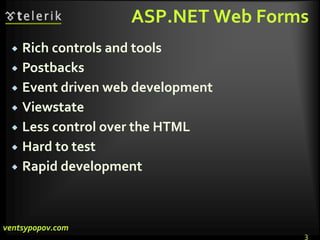


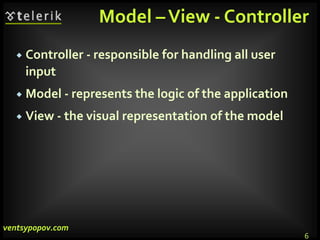
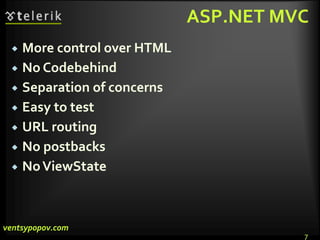
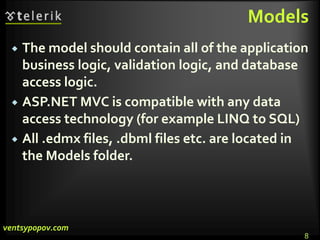


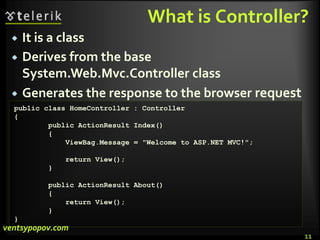

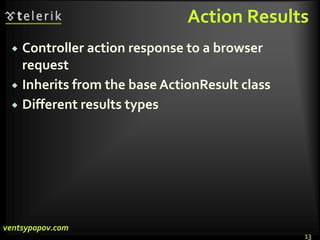

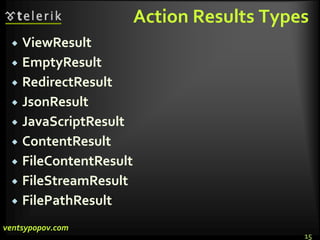


![Pass Data to a View
ïŪ WithViewData:
ïŽ ViewData["message"] = "Hello World!";
ïŽ Strongly typedViewData:
ï ViewData.Model = OurModel;
ïŪ WithViewBag:
ïŽ ViewBag.Message = "Hello World!";
18
ventsypopov.com](https://image.slidesharecdn.com/z9h1xocnr0srum6ubemv-asp-230925162544-b389111e/85/ASP-NET-MVC-Part-1-ppt-18-320.jpg)
![Post data to a controller
ï Verb Attributes
ï The action method in the controller accepts the
values posted from the view.
ï The view form fields must match the same
names in the controller.
19
ventsypopov.com
[HttpPost]
public ActionResult Edit(Movie movie)
{
if (ModelState.IsValid)
{
db.Entry(movie).State = EntityState.Modified;
db.SaveChanges();
return RedirectToAction("Index");
}
return View(movie);
}](https://image.slidesharecdn.com/z9h1xocnr0srum6ubemv-asp-230925162544-b389111e/85/ASP-NET-MVC-Part-1-ppt-19-320.jpg)
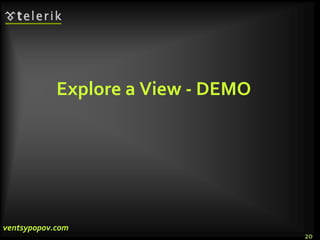
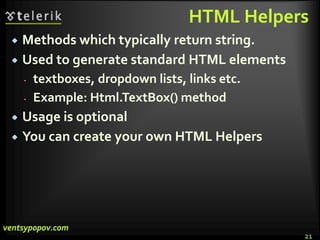


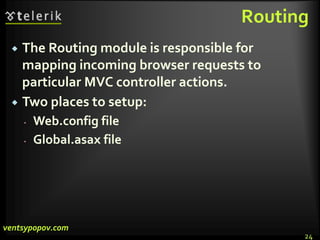










![Questions?
ASP.NET MVC
ventsypopov.com
Email: vepopov [at] microsoft.com
Twitter: @v_popov](https://image.slidesharecdn.com/z9h1xocnr0srum6ubemv-asp-230925162544-b389111e/85/ASP-NET-MVC-Part-1-ppt-35-320.jpg)
